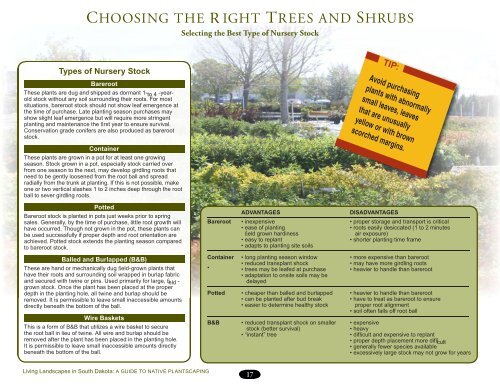Living Landscapes in South Dakota - Plant Materials Program - US ...
Living Landscapes in South Dakota - Plant Materials Program - US ...
Living Landscapes in South Dakota - Plant Materials Program - US ...
You also want an ePaper? Increase the reach of your titles
YUMPU automatically turns print PDFs into web optimized ePapers that Google loves.
CHOOSING THE R IGHT TREES AND SHRUBS<br />
Select<strong>in</strong>g the Best Type of Nursery Stock<br />
Types of Nursery Stock<br />
Bareroot<br />
These plants are dug and shipped as dormant 1- to 4 -yearold<br />
stock without any soil surround<strong>in</strong>g their roots. For most<br />
situations, bareroot stock should not show leaf emergence at<br />
the time of purchase. Late plant<strong>in</strong>g season purchases may<br />
show slight leaf emergence but will require more str<strong>in</strong>gent<br />
plant<strong>in</strong>g and ma<strong>in</strong>tenance the first year to ensure survival.<br />
Conservation grade conifers are also produced as bareroot<br />
stock.<br />
TIP:<br />
Avoid purchas<strong>in</strong>g<br />
plants with abnormally<br />
small leaves, leaves<br />
that are unusually<br />
yellow or with brown<br />
scorched marg<strong>in</strong>s.<br />
Conta<strong>in</strong>er<br />
These plants are grown <strong>in</strong> a pot for at least one grow<strong>in</strong>g<br />
season. Stock grown <strong>in</strong> a pot, especially stock carried over<br />
from one season to the next, may develop girdl<strong>in</strong>g roots that<br />
need to be gently loosened from the root ball and spread<br />
radially from the trunk at plant<strong>in</strong>g. If this is not possible, make<br />
one or two vertical slashes 1 to 2 <strong>in</strong>ches deep through the root<br />
ball to sever girdl<strong>in</strong>g roots.<br />
Potted<br />
Bareroot stock is planted <strong>in</strong> pots just weeks prior to spr<strong>in</strong>g<br />
sales. Generally, by the time of purchase, little root growth will<br />
have occurred. Though not grown <strong>in</strong> the pot, these plants can<br />
be used successfully if proper depth and root orientation are<br />
achieved. Potted stock extends the plant<strong>in</strong>g season compared<br />
to bareroot stock.<br />
ADVANTAGES<br />
DISADVANTAGES<br />
Bareroot • <strong>in</strong>expensive • proper storage and transport is critical<br />
• ease of plant<strong>in</strong>g<br />
• roots easily desiccated (1 to 2 m<strong>in</strong>utes<br />
field grown hard<strong>in</strong>ess<br />
air exposure)<br />
• easy to replant<br />
• shorter plant<strong>in</strong>g time frame<br />
• adapts to plant<strong>in</strong>g site soils<br />
Balled and Burlapped (B&B)<br />
Conta<strong>in</strong>er • long plant<strong>in</strong>g season w<strong>in</strong>dow • more expensive than bareroot<br />
• reduced transplant shock<br />
• may have more girdl<strong>in</strong>g roots<br />
These are hand or mechanically dug field-grown plants that •<br />
• trees may be leafed at purchase • heavier to handle than bareroot<br />
have their roots and surround<strong>in</strong>g soil wrapped <strong>in</strong> burlap fabric<br />
• adaptation to onsite soils may be<br />
and secured with tw<strong>in</strong>e or p<strong>in</strong>s. Used primarily for large, fi eld -<br />
delayed<br />
grown stock. Once the plant has been placed at the proper<br />
depth <strong>in</strong> the plant<strong>in</strong>g hole, all tw<strong>in</strong>e and burlap should be Potted • cheaper than balled and burlapped • heavier to handle than bareroot<br />
removed. It is permissible to leave small <strong>in</strong>accessible amounts • can be planted after bud break • have to treat as bareroot to ensure<br />
directly beneath the bottom of the ball. • easier to determ<strong>in</strong>e healthy stock proper root alignment<br />
• soil often falls off root ball<br />
Wire Baskets<br />
B&B • reduced transplant shock on smaller • expensive<br />
This is a form of B&B that utilizes a wire basket to secure<br />
stock (better survival)<br />
• heavy<br />
the root ball <strong>in</strong> lieu of tw<strong>in</strong>e. All wire and burlap should be • “<strong>in</strong>stant” tree • difficult and expensive to replant<br />
removed after the plant has been placed <strong>in</strong> the plant<strong>in</strong>g hole.<br />
• proper depth placement more diffi cult<br />
It is permissible to leave small <strong>in</strong>accessible amounts directly<br />
• generally fewer species available<br />
beneath the bottom of the ball.<br />
• excessively large stock may not grow for years<br />
<strong>Liv<strong>in</strong>g</strong> <strong>Landscapes</strong> <strong>in</strong> <strong>South</strong> <strong>Dakota</strong>: A GUIDE TO NATIVE PLANTSCAPING<br />
17

















